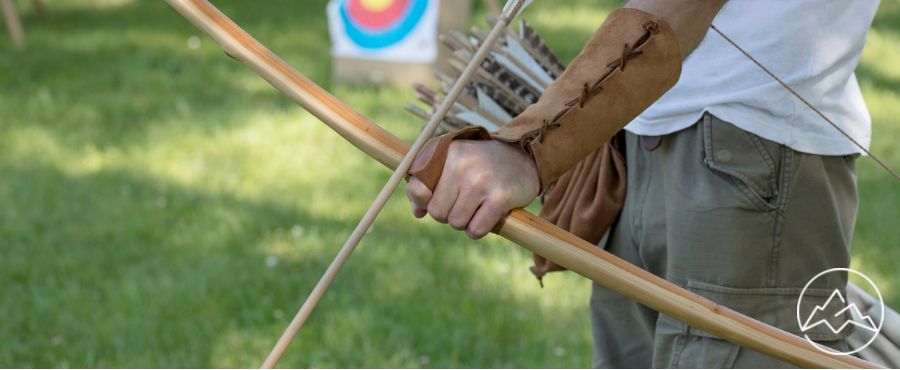If you’re getting into archery, you might be considering what kind of bow to get. There are many different types of bows, including compound bows, recurve bows, crossbows, etc., and the trusty longbow.
As archery becomes more popular, loyal fans turn to longbows and recurve bows.
If you can’t decide between them, you should consider the pros and cons of each category. We’ll start by looking at each bow type’s defining features.
Longbows
The limbs of a longbow don’t curve away, and the longbow is a classic single-piece style of bow. Longbows, true to their name, are the longest bows available.
They don’t have any extras, such as cams, etc., to increase power. They comprise a single piece of wood and can be as big as an archer, standing up to 1.8m (6ft) tall.
Modern longbows are shorter than traditional longbows but retain the same shape and functionality. They are made with composite materials thanks to newer techniques, including lamination. Some may have removable limbs, making them takedown longbows.
Recurve bow
Modern recurve bows are the most popular type now, and they are the only kind of bow used by Olympic archers. Recurve bows have limbs that curve towards the archer; that curve is known as the recurve and stores more power than a longbow of the same size.
Next, we’ll be comparing recurve bows against longbows in several categories to help you decide which is best for you.
Power
Longbows and recurves have similar power ranges; 70 lb should be considered the maximum draw weight for either. The recurve will store more power than the simple D curve in the longbow.
A recurve usually delivers more power if you compare two bows of the same draw weight, draw length, etc., under the same conditions.
Winner: Recurve
Aiming
Recurves are easy to aim with when you know how, but more things can go wrong. You have more leeway with a longbow; the cross-section of the riser and the limbs are thicker than a recurve. There’s less chance of awkward sideways movement or torquing upon release.Winner: Longbow
Noise
Noise is a difficult category, but there’s less contact between the limbs and string of the longbow, so if you’ve got a good setup, it’s quieter. There’s nothing that can cause a string slap. Recurves have more potential for string slap.
Winner: Longbow
Size
A longbow is quite a bit bigger than a recurve, and the recurve is much more efficient, so the limbs don’t need to be large. A modern 60lb longbow is usually more than 64″ long, but a recurve of the same weight can be 58 inches or less.
Winner: Recurve
Portability
Most recurve bows are takedown, meaning you can easily break them down into three pieces to transport them. Most can be broken down into three pieces, riser, top, and bottom limb.Takedown longbows are increasingly available, but they are rarer. Generally, a longbow is made of one piece of wood (or laminated wood). Recurve bows are also smaller, may also be lighter, and have several advantages.
Winner: Recurve
Adjustability
You can’t really adjust either bow, but you can purchase various limbs and upgrades for the takedown recurve bow to increase or decrease power output. You could do the same for a takedown longbow, but these are rarer. There’s no way to increase or change power in a traditional (one-piece) longbow.
Winner: Recurve
Construction
Next up, let’s compare the manufacturing techniques used for recurve and longbows. There’s no clear winner, but comparing the difference is nonetheless interesting.
Cost
There are no major cost differences, and the construction and manufacturing techniques involved for both groups are very similar, so there’s no clear winner.
Draw
Maintenance and repair
You can re-string each bow yourself, without any special tools. But a broken one-piece longbow can’t really be repaired. akedown recurve bows can have parts replaced and continue to function.
Winner: Recurve
Accessories
You can find all kinds of accessories for both bow types, including sights, arrow rests, stabilizers, string silencers, limb dampeners, etc. There’s no obvious best choice in this category.
Draw
Availability and choice
Recurves are the modern standard and are used most by clubs, tournaments, and archers. They are also used by Olympic competitors. Longbows aren’t used as much and have less variety available. You can check out basically any provider and find the same result; there’s always a larger selection of recurves available.Winner: Recurve
Bowhunting
If you’re choosing between the two for hunting, pick the recurve. The recurve is easier to draw, smaller, and more portable. It also performs better most of the time. Longbows are very difficult to hunt with.
Winner: Recurve
Youth bows
Bows for young people are usually less powerful and easier to handle than adult bows. The recurve is more modern, widely used, and versatile than the longbow. I’d choose the recurve if you’re looking for a first bow; it’ll be smaller, easier to handle, and more compatible with the best technologies. But the simplicity of a longbow isn’t to be overlooked, either. Still, most youth archers would prefer a recurve.
Winner: Recurve
Beginner bows
Really, it’s personal preference, and there’s no clear winner here. At a ‘try archery’ event, you’ll usually be given a recurve bow due to increased availability and reduced size. But the simplicity of a longbow shouldn’t be overlooked either; you might want to begin by learning with a longbow before branching out into a recurve.
Winner: Draw
Target archery
Target shooters can find events for both disciplines, but there is less variety for longbow shooters than recurve shooters. A recurve shooter can go all the way to the Olympic level. Traditional archery is a fun pastime, but there’s not much availability for traditional bow users.
Winner: Recurve
Longbow vs recurve
Recurve and longbows are the most popular bows in the archery industry, with pros and cons exclusive to each. The longbow is one of the oldest and is straightforward but has slowly fallen out of use. The recurve is gaining popularity and has many key benefits, including being available in takedown models and being more portable.
Despite these differences, it all comes down to preference.
If you’re looking for a simpler piece of kit with less to adjust or fix, and want a more traditional feel, then you can try the longbow. But if you’re an aspiring hunter looking for portability and ease, then a recurve bow is ideal.



